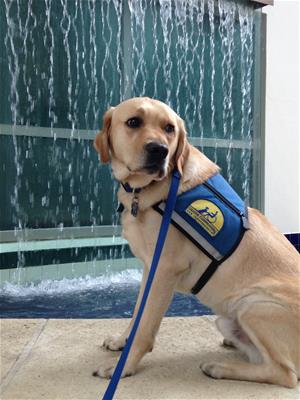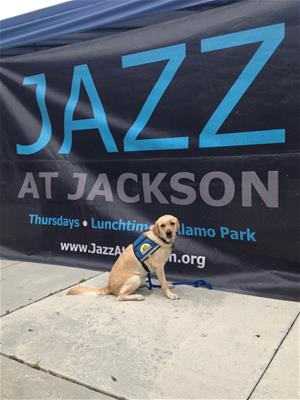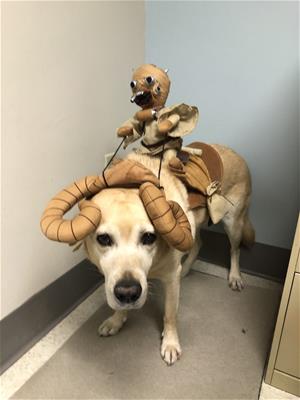Interview with Regatta, a Jackson Memorial Rehabilitation Facility Dog

Scott E. Klass, MD, MS, ATC
PGY4, University of Miami/Jackson Health System PM&R Program
Told by Co-facilitators Melanie Orell (physical therapist) and Cathy Herring (recreational therapist)
 How did you get the idea to have a therapy dog here?
How did you get the idea to have a therapy dog here?
Cathy: I had been thinking about having a therapy dog visit the facility. Coincidentally, one of our patient’s family members was a dog breeder, who suggested that I get a facility dog of my own. I started the process that day. After 2 years, I got Jean. Jean was a Labrador and Golden Retriever mix, who used to ride the Metrorail to work with me while serving Jackson Memorial Hospital for 11 years, before passing away from cancer.
Melanie and I did a lot of co-treatments with Jean, so when it was time for a new therapy dog Melanie said, “I’ll do it with you.” We applied as co-facilitators to Canine Companion, which supplies trained dogs and we began our 2 weeks of training. We worked with 3 or 4 different dogs until they decided that Regatta worked best with us. For the rest of the 2 weeks, we focused on tasks with Regatta. and Before long, he was ready to be our new facility dog.
Help us get to know Regatta. What is he like?
Cathy and Melanie: Well he’s a 6.5-year-old Golden Retriever and he has a lot of hair. Regatta knows 45-60 English commands, with some Spanish and Haitian Creole as well. He’s at his happiest when he’s on a walk or getting treats, and carrots are his favorite treat. His official title is as a “facility dog”, which is the same level of training as a service dog, with the only difference being that the owners are able-bodied. He will work until he’s 9 or 10 years old, and then he will retire to a normal dog life.
 What should the health care team know when interacting with a working dog?
What should the health care team know when interacting with a working dog?
Cathy: A lot of doctors, residents, therapists, and other healthcare workers come running up to Regatta and want to pet him. What they don’t realize that a service dog is trained to be attentive to their patient 24/7. It can be very dangerous if he loses concentration, because he could turn too quickly and knock over a patient or their assistive device without meaning to. Instead, Regatta has a command “release,” so he knows it’s ok to break the session. So before you say, “Hello,”’ always ask the trainer.
How do you determine the patients that might get the most benefit from Regatta?
Cathy: In my recreational therapy evaluation, I gauge their interest by asking about their experiences with animals. Then I watch the patients in the gym, and when I see someone struggling with a task, I think about how Regatta could help them. Physical therapy (PT), occupational therapy (OT), or speech therapy (ST) teams will often come to me and say they have a patient who likes when the dog is around, and together we’ll come up with a plan to use Regatta in their sessions.
 What are some of the ways you implement Regatta in treatment sessions?
What are some of the ways you implement Regatta in treatment sessions?
Cathy: Many different ways, but here are some examples. In PT, I get up on the mat, Regatta will visit the mat at different locations, and the patient will move around to greet him.
In OT, we work on gross motor skills by brushing Regatta’s hair. I will leverage baby carrot treats to work on pinch grip. The patient moves around the mat to give Regatta treats. With our brain-injured patients, we work on voice production, speech, and memory issues by giving Regatta commands.
In ST, we walk Regatta, which includes remembering 3 commands, pronouncing them, and doing so in the right order. With the pediatric patients in wheelchairs, we play a game called “Hide and Go Seat”. First, we hide Regatta’s toy chicken while Regatta himself hides. Then Regatta returns to look for his toy, while the child follows Regatta in his wheelchair and gives clues by saying “hot” or “cold” until Regatta finds it. All the kids love to play that game, and they're maneuvering their wheelchair the whole time.
 What are the benefits of using Regatta in treatment sessions?
What are the benefits of using Regatta in treatment sessions?
Cathy: The outcome of the session is better nearly 100% of the time. The patient is just smiling and participating more.
Melanie: Regatta brings a calm, soothing presence to my therapy sessions. He also helps the staff by putting a smile on everybody’s face. Having Regatta around is crucial in making the team’s mood brighter, which leads to better sessions for everyone.
Cathy: I remember a young boy trying to manipulate his legs who kept saying, “No, I’m afraid, I can’t.” He was very focused on his lack of ability. We decided to use Regatta to make his therapy a game. Eventually, the kid was moving all over just trying to keep Regatta happy. It was truly amazing. Another boy was having trouble brushing his teeth, so we let him brush Regatta’s teeth. That little boy got over his fear and started brushing his teeth that night. We’ve also had adults working on bending down and all they would say is, “No, I’m going to fall.” When we bring Regatta and there’s a toy on the ground, they bend over without thinking and pick it up. Those moments are magical because the patient is no longer thinking about the fear, pain, or anxiety when they do the task. It often surprises them afterward, when we show them what they were able to accomplish.
 What happens when Regatta goes home for the day?
What happens when Regatta goes home for the day?
Cathy and Melanie: First, his jacket comes off. Then he’s able to run around and play, nap, and just be a regular dog. They work hard, and it is challenging for a dog to stay focused for such a long period. Therapy dogs need to recharge themselves just like us.
What is Regatta’s funniest personality trait?
Melanie: My favorite is that he likes to roll over and snore right in the middle of the therapy mat if no one is petting him. But the second somebody comes over to him, he rolls over again as if to say, “Oh please pet my belly.”
What advice would you have for anyone trying to get a therapy dog in his or her institution that may not have one?
Cathy: I would say do it now, and get more than 1!